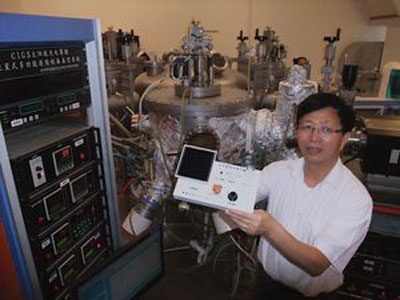| Jun 07, 2011 |
High-efficiency CIGS thin film solar cell can be fabricated inexpensively
|
|
(Nanowerk News) Researchers at the Chinese University of Hong Kong have developed Cu(InGa)Se2 (CIGS) thin film solar cells with high efficiency and that can be made inexpensively.
|
|
Led by Prof. Xudong Xiao and Prof. Quan Li of the Department of Physics, the researchers achieved a conversion efficiency of 17% with a CIGS solar cell that is thin and portable. Thin-film solar cells can be installed on roofs and outer walls and can also be integrated into consumer products such as handbags and backpacks for charging electronic products instantly.
|
 |
| Prof. Xudong Xiao of the Department of Physics demonstrates the use of CIGS thin film solar cell at his laboratory where it is produced.
|
|
The development is important for Hong Kong, where about 75% of electricity is generated from coal and natural gas and the remaining 25% is mainly from nuclear energy. It is estimated that 40% of electricity consumed in Hong Kong could be supplied by solar cells if they were installed on all building roofs in the city, reducing 15 million tons of carbon emission annually.
|
|
"The current solar cell market is dominated by crystalline silicon solar cell with a market share of 90%, which is also the most popular type being used in Hong Kong," said Xiao and Li. "It is forecasted that the market share of thin film solar cell will increase from 10% to 35% in the coming 20 years. Among various types of thin film solar cell, CIGS solar cell has the highest efficiency, comparable to crystalline solar cell, yet 50 times thinner and fabrication costing 50% less. When mass production technology matures and becomes widely adopted, we believe that CIGS will be the most cost competitive solar cell, demonstrating bright market prospects."
|
|
CIGS solar cells are made by depositing multilayer thin film material of 1/200 mm in total thickness on low-cost substrates such as glass, plastic and metal foil. It can generate electricity even in cloudy weather and dim light, which best suits Hong Kong's environment with dense high-rise buildings.
|
|
The two-year research project is conducted at the Chinese University of Hong Kong and the Shenzhen Institute of Advanced Technology, Chinese Academy of Sciences. It is is supported by Chinese University of Hong Kong, the Innovative Technology Council, the Chinese Academy of Sciences (CAS), and the Shenzhen government.
|

